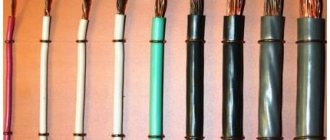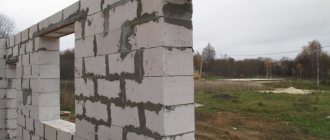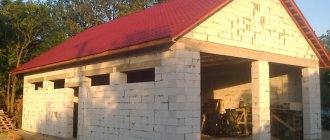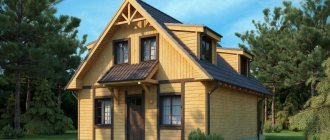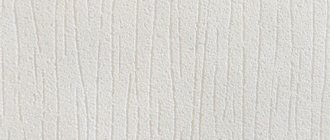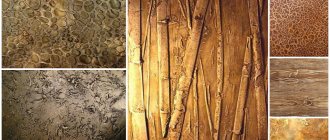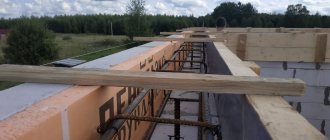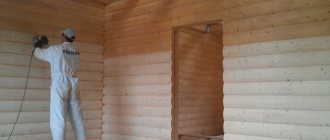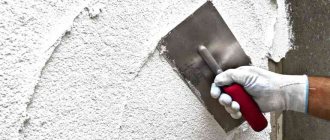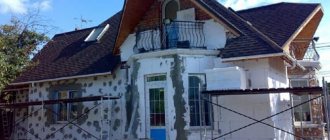- Plaster
- How to correctly calculate plaster consumption
- KNAUF ROTBAND
The finishing coating applied to cellular concrete masonry, in addition to providing an aesthetic appearance, also has protective functions. It insulates the masonry surface from mechanical damage and waterlogging, and reduces the likelihood of blowing through the walls to zero. The standard for finishing aerated concrete walls imposes certain requirements on vapor permeability, frost resistance, water absorption and adhesion. According to the unanimous opinion of experts, aerated concrete plaster is considered the best material that meets all these requirements at once. Why? You will learn about this by reading the material presented here.
Basic requirements for plaster
It is worth noting right away that it is not recommended to apply ordinary plaster to a house made of aerated concrete blocks. Primarily because standard sand solutions are high-density, this leads to poor adhesion when applied to aerated concrete blocks and the rapid appearance of cracks.
Adhesion (from Latin adhaesio - sticking) in physics is the adhesion of the surfaces of dissimilar solids and/or liquids.
The plaster should maintain an optimal microclimate inside the building, protecting the walls from moisture. Therefore, you should choose mixtures with a vapor-permeable base. Otherwise, the steam coming out of the house will get stuck inside the walls, since the plaster will simply block its exit to the outside. Thus, moisture will begin to accumulate in the walls, which will ultimately lead to their destruction. Of course, nothing will happen to the house in a few years, but in six to eight years, an almost irreversible process of destruction will begin.
Plaster for aerated concrete should be:
- resistant to external weather influences;
- have good adhesion (adhesion to aerated concrete);
- resistant to sudden temperature changes;
- high degree of compressive strength (protection against cracking);
- vapor permeable;
- moderately dense;
- improving the thermal insulation of walls;
- have a decorative appearance.
When choosing plaster for aerated concrete, you should not ignore any of the points listed above.
Applying plaster to a house made of aerated concrete blocks Source emupauto.ru
The absence of facade finishing of aerated concrete structures will lead to darkening, deformation, and peeling of the surfaces of the blocks.
Advantages of gas silicate
First, let's briefly look at the performance characteristics of the building material. Aerated concrete has a number of obvious advantages that explain the popularity of its use. In addition to the already mentioned attractive cost, these include:
- Clearly consistent block size. This allows for laying in perfectly even rows, and not a thick layer of ordinary mortar is used to adhere the blocks, but a thin layer of a special adhesive composition. As a result, “cold bridges” that cause a lot of inconvenience in the future do not form in the masonry.
- Light weight. The intensity of the load on the foundation and, as a consequence, the likelihood of uneven shrinkage depends on the total mass of the structure. If you follow the technology for laying lightweight aerated concrete blocks and carry out the necessary procedures for reinforcing the structure, you can not be afraid of distortions in the house and the appearance of wall cracks.
- Heat and sound insulating properties. According to this indicator, gas silicate occupies a leading position among the main building materials. The porous structure creates excellent energy-saving characteristics and prevents the penetration of external noise.
- High vapor permeability. This property of the material ensures the maintenance of a constant microclimate in the interior. The house will not be damp when it rains, and you will not have to use humidifiers in the dry heat.
Types of plasters suitable for aerated concrete blocks
The choice of plaster mixture for aerated concrete primarily depends on whether you are going to cladding the walls from the outside or from the inside. Based on the type of application, plasters are divided into external and internal.
As you understand, external plaster is intended for finishing facades. Since here it performs protective functions, its strength, moisture resistance and thermal insulation indicators should be higher.
Internal mixtures are intended for finishing indoor walls, so the presence of moisture resistance in the characteristics of these plasters can be ignored, with the exception of cases of wall cladding in the bathroom. Due to the lack of resistance to moisture, internal mixtures are much cheaper than external ones.
Applying a finishing layer of plaster to aerated concrete Source o-cemente.info
Popular plasters for aerated concrete
Mixtures for finishing facades made of aerated blocks are divided according to the type of composition into:
- lime-cement;
- acrylic;
- silicate;
- silicone.
Lime-cement mortars are quite durable and at the same time vapor-permeable, because their main component is lime, which replaces sand. This type of plaster is popular due to its low cost. So if your task is to make a budget cosmetic repair of the facade or finish the basement, this option is suitable.
an acrylic mixture on the plinth; if you choose it for finishing a facade made of aerated concrete, then be prepared for the fact that in 8-10 years the facade will need to be completely renewed. Since the life of acrylic polymer plaster is maximum 10 years. Such plaster cannot boast of good vapor permeability, moisture resistance and elasticity.
Silicate plaster for aerated concrete is produced on the basis of liquid potassium glass. The coating has good moisture resistance, vapor permeability and durability. The silicate solution is easy to apply. The finishing layer is resistant to dirt and abrasion, providing a decorative finish for a long time (more than 25 years). The problem with silicates is the limited choice of colors.
Leveling walls with silicate plaster Source lineyka.net
Silicone polymer plaster contains acrylic and silicone copolymers. Which make the plaster what it is. The quality characteristics of the material are optimal for creating a durable coating. Silicone plaster has one of the best elastic properties, which ensures the absence of cracks on the surface even when the blocks shrink.
Silicone plaster can undoubtedly be called a leader among others; it has all the most important properties that facade plaster should have, which guarantees you a beautiful and durable facade for many years.
It is not recommended to plaster structures made of aerated blocks using cement-sand mixtures. They do not fit well on the surface of aerated concrete and crack over time.
See also: Catalog of companies that specialize in finishing materials.
Most popular manufacturers
The building materials market is saturated with a huge number of plaster mixtures of various brands for finishing aerated concrete surfaces. Popular compositions have optimal characteristics for the work.
Applying plaster to the interior walls of a house made of aerated blocks Source obustroeno.com
Ceresit CT 24. The mineral composition of the mixture gives the solution plasticity. The material is easy to apply. The coating can withstand up to 100 cycles of low temperature influences. It is recommended to paint after complete drying (after seven days).
CERESIT ST 77. The acrylic type of the mixture is used for facade finishing, ensuring the strength of the coating with a fairly thin layer of application. The material is frost-resistant and resistant to external influences. Used when there is waterproofing and ventilation inside the house.
Founded by Startwell T-21. Cement-lime plaster is frost-resistant and has a sufficient level of adhesion. The resulting coating is resistant to shrinkage and moisture.
Advantages and disadvantages
Gas silicate is often called aerated concrete. This is not entirely correct. The difference between them is insignificant. In aerated concrete, the main binding element is Portland cement, while in aerated silicate it is lime. The second block will appear lighter than the first. There are slight differences in technical specifications. However, they are not of a fundamental nature.
The popularity of gas silicate is explained by a number of its advantages.
- The aerated block has a low price, which can significantly reduce the cost of construction.
- It is light in weight. If you compare gas silicate and concrete blocks of the same size, the first will weigh five times less than the second. This allows you to make a less powerful foundation, and therefore also reduce costs.
- Gas silicate has low thermal conductivity. They are eight times lower than that of brick. Therefore, the material is often used in countries with cold climates.
- It has high soundproofing qualities.
- GSB allows steam to pass through well.
- Gas silicate is safe from an environmental point of view.
- The blocks are produced with strict linear shapes, which speeds up their laying.
